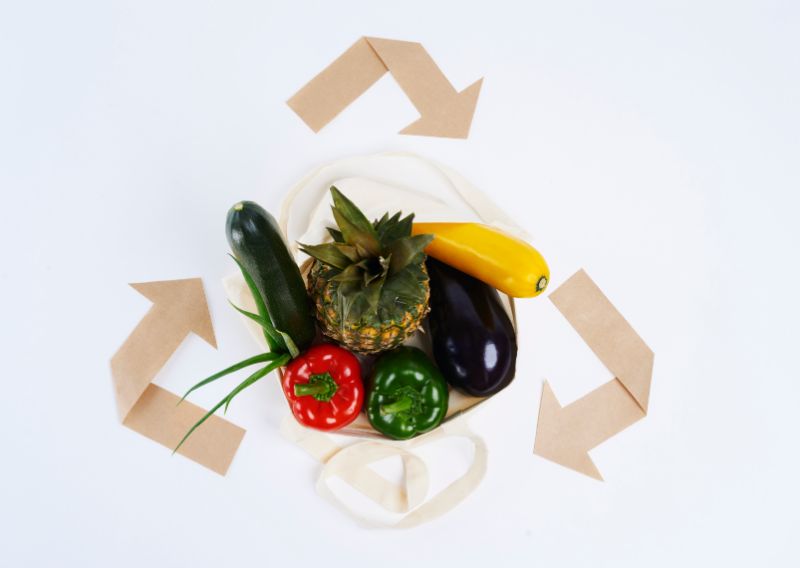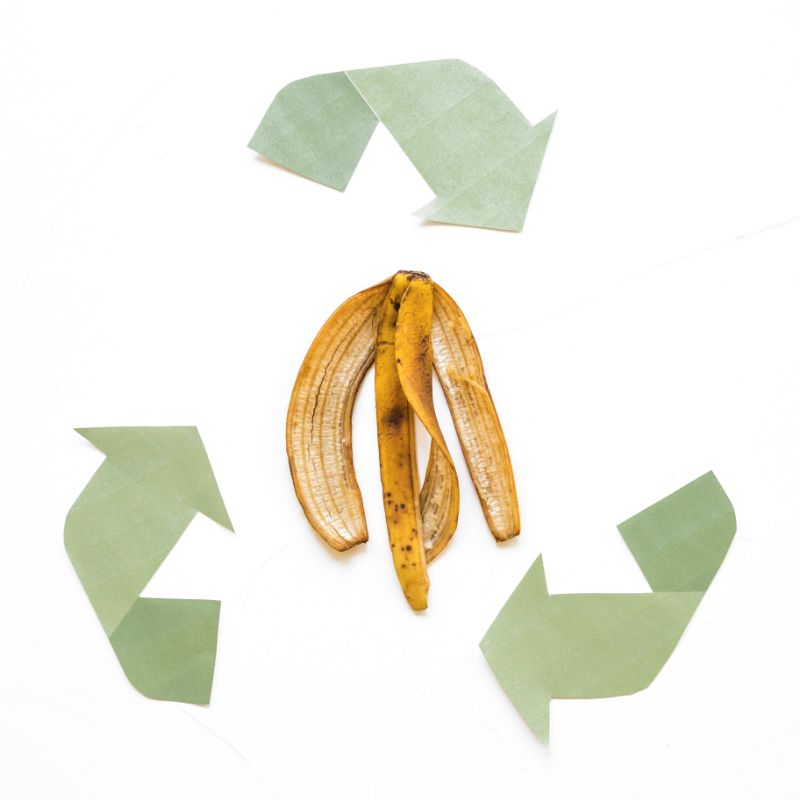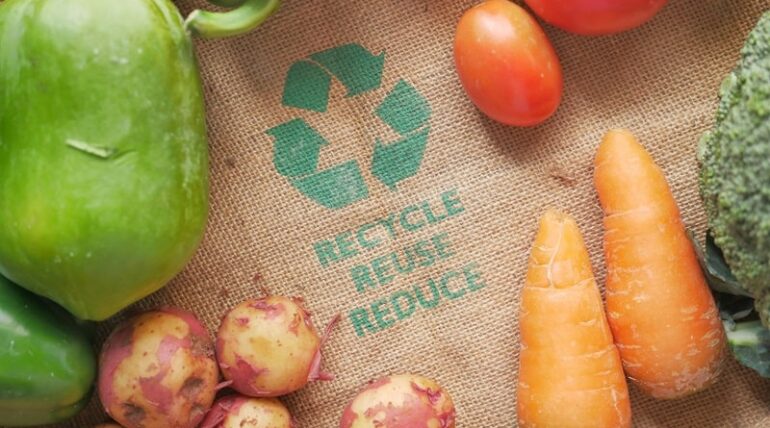“Take, make, and dispose.”
This refers to the current economy that we live in, in which we take natural resources, make things out of them, and dispose of them when we’re done. Unfortunately, this lifestyle is exactly why roughly one-third of food produced for human consumption is lost or wasted globally.
With severe environmental, economic, and social consequences, new strategies must be explored to approach the current food waste crisis, such as the implementation of a circular economy.
So how are the circular economy and food waste connected? Keep reading to explore circular economy waste management, the challenges of implementing it, and innovative solutions within the circular economy framework.
Key Takeaways
- A circular economy is a system that focuses on avoiding waste and reusing and regenerating materials or products to preserve their value. This system is based on 3 principles: reduce, reuse, and recycle.
- The benefits of a circular economy include reduced food waste, less methane emissions, increased resource efficiency, improved food security, and economic savings, among others.
- Many food waste circular economy strategies can be implemented throughout the supply chain, such as precision farming, optimized logistics, smart packaging technologies, the implementation of food waste technology, and increased consumer awareness.
- Technologies such as artificial intelligence and blockchain are shaping the future of food waste and circular economy by enabling real-time monitoring, optimizing processes, forecasting demand, and opening the opportunity to reduce waste throughout the supply chain.
The Impact of Food Waste
Food waste statistics show us the implications of food waste around the world, with around 1.4 billion hectares, or 28% of the world’s total agricultural area, used to produce food that is lost or wasted.
The environmental impacts of food waste are large, leading to air and water pollution, degradation of land, a loss of biodiversity, and overuse of landfills. Food waste in landfills, in particular, is a growing issue, as the decomposition process produces methane emissions, a powerful greenhouse gas that contributes to global warming.
Food waste also wastes all the resources used to produce it; it consumes around 25% of all water used by agriculture each year, 23% of all croplands, and generates around 8% of annual global greenhouse gas emissions.
There’s also an economic impact of food waste that affects both businesses and individuals. With global food waste reaching 1.3 billion tons of food each year, it causes economic losses of $750 billion to food producers. In the United States alone, wasted food costs $218 billion, or 1.3% of GDP, annually. Losses in the supply chain affect everyone involved, from producers to retailers to households.
Food waste is also a social issue, as food insecurity is a global crisis that needs to be addressed. With as many as 783 million people facing chronic hunger, there’s an urgent need for more efficient food waste reduction strategies. The implementation of circular economy food waste management is an innovative solution that could help address food insecurity and save valuable resources.

Principles of Circular Economy
The concept of a circular economy became popular in China in the 1990s in response to economic growth and natural resource limitations. Today, this approach is used across the globe and can be applied to a number of industries.
So, how are food waste and the circular economy connected?
Keep reading to learn what the circular economy entails, how it compares to the linear economy, and how it affects the fight against food waste.
What is Circular Economy?
A circular economy is a system that focuses on avoiding waste and reusing and regenerating materials or products to preserve their value. This system is based on 3 principles: reduce, reuse, and recycle. As stated by the United States Environmental Protection Agency, a circular economy “reduces material use, redesigns materials and products to be less resource intensive, and recaptures “waste” as a resource to manufacture new materials and products.”
By eliminating waste and pollution, keeping natural resources in circulation, and regenerating natural systems, a well-developed circular waste system reduces food waste while addressing the environmental, economic, and social implications mentioned above.
Linear vs Circular Economy: A Comparative Analysis
A linear economy is a system in which people buy a product, use it, and throw it away. This approach has many consequences, such as the extraction of resources, contribution to waste and pollution, and harm to natural systems.
Many businesses and consumers have adopted the linear approach, putting pressure on scarce and valuable resources and showing little concern for the environmental and social impact. So how does this differ from the circular economy?
While the linear economy is notoriously wasteful, the circular waste economy focuses on extending the lifecycle of products. Rather than disposing of a product after one use, circular economy recycling focuses on the continuous circulation of materials.
This approach can be applied to any industry, making the circular economy and food waste an important topic in building a more sustainable future.

The Role of Circular Economy in Combating Food Waste
There are many ways the circular economy can be applied to the supply chain to address both avoidable and unavoidable food waste. As mentioned, a circular economy aims to reduce, reuse, and recycle, as shown below:
- Reduce: With overproduction being a huge contributor to food waste, reduction may be the most important part of circular economy waste management, which can be applied at every stage of the supply chain. Some of the ways to reduce waste are to improve demand forecasting, avoid discarding “ugly” produce, enhance distribution and transportation logistics, and stop bulk purchasing.
- Reuse: One of the best ways to keep food in circulation is to donate excess food. Food donations divert food waste from landfills and have a positive influence on the community. Other ways to reuse food include repurposing ingredients to make new products, such as turning leftover products or ingredients into new recipes or even turning food into animal feed.
- Recycle: Recycling is a great alternative for food waste that can’t be prevented, donated, or reused in some way. Everyone can get involved in circular economy recycling efforts, whether through large-scale recycling strategies for high-waste organizations or by joining community recycling efforts. Food waste recycling, which includes composting and anaerobic digestion, helps keep food out of landfills, therefore reducing its environmental impact.
Benefits and Challenges of a Circular Food Waste Economy
A circular waste economy is a holistic solution in the fight against food waste. That said, implementing a circular economy comes with both advantages and challenges, as we’ll see below.
Advantages of a Circular Economy in Reducing Food Waste
Reducing food waste and keeping food products in circulation not only diverts food from landfills, but it prevents natural resources from being wasted as well. The benefits?
- Combats climate change: Diverting food from landfills reduces the amount of methane emissions produced from food waste, making a circular economy in the food industry an important component of fighting climate change.
- Resource efficiency: Maximizing the value of resources ensures that resources are fully utilized, reducing the need for additional production.
- Improves food security: Community and nation-wide food donation efforts mean that more people have access to food, therefore supporting local communities and addressing the food insecurity crisis.
- Economic savings: Embracing a food waste circular economy reduces the economic loss endured in the supply chain and can even potentially generate a new revenue stream from repurposed products.
- Reconnects cities with food and farmers: Local sourcing helps support a regenerative agricultural system, which has a positive effect on the community and creates more sustainable practices.
Challenges and Barriers to Implementing Circular Economy Solutions
Common challenges involving food waste and circular economy include:
- Changing consumer behavior: In today’s age, consumers are accustomed to large portion sizes, readily available food, and strict food aesthetic standards. To address modern-day consumption habits, there should be an increase in consumer education campaigns.
- Regulations: Unfortunately, not all regulations support a circular economy, such as strict cosmetic standards, waste management policies that prioritize disposal over recovery, and a lack of protocols regarding expiration dates. With increased government regulations, there could be a more widespread implementation of a circular economy.
- Lack of proper waste infrastructure and technology: Not all companies and communities have the proper resources to reduce waste and implement circular economy waste management. Government initiatives and support could help bridge this gap, offering valuable resources, funds, and education to communities that support a circular economy.
- Lack of coordination in supply chains: Many times, there is bad supply chain coordination between manufacturers, distributors, retailers, and consumers. To prevent overproduction and food spoilage, coordinating efforts must be improved, which can be enhanced with food waste technology and improved communication.

Strategies and Solutions for Circular Food Waste Management
There are various sustainable food waste solutions that can be implemented throughout the supply chain to manage and reduce food waste. Keep reading to learn how the food waste circular economy can be applied to agricultural practices, the importance of fostering consumer awareness, innovations in food waste management, and more.
Optimizing Agricultural Practices
There are multiple ways that farmers and producers can support the transition to a circular economy, particularly through precision farming and sustainable crop management.
- Precision farming: Precision farming is an approach that ensures optimal crop growth and yield by applying site-specific crop management. Overall, it works to reduce food waste due to overproduction and resource mismanagement, therefore improving resource efficiency. Some strategies that encompass precision farming include agricultural mapping and field scouting, soil sampling and analysis, weather monitoring, and equipment management. Many food waste technologies are also on the rise, including GPS and mapping systems, remote sensing technologies, satellite imagery, autonomous vehicles, and much more.
- Sustainable crop management: Sustainable crop management involves agricultural production that does not impose harm to the environment, biodiversity, or the quality of agricultural crops. Common practices include crop rotation, conservation tillage, cover cropping, agroforestry, and much more.
Reducing Waste in Processing and Packaging
A circular waste system can greatly impact the amount of waste produced during the processing and packaging stages. Here are some of the strategies that can be implemented:
- Optimized logistics: Efficient logistics and distribution strategies can help minimize the amount of food that spoils during storage and transportation. This may include minimizing transport distances, optimizing inventory management, using technology to regulate temperature and humidity, and employing data analytics and predictive modeling to prevent overproduction.
- Smart packaging technologies: Smart packaging technologies leverage sensors and indicators to monitor the product’s condition in order to extend its shelf life, reduce waste, and improve its freshness. Examples of this include freshness sensors, QR codes, and RFID technology, among others.
- Improved packaging design: Enhanced packaging design can help maximize product protection and shelf life while minimizing material usage. There are many innovative packaging solutions that minimize plastic waste and environmental impact, such as edible food packaging, a packaging solution made up of natural, biodegradable materials.
Fostering Consumer Awareness and Behavior Change
One of the key aspects of reducing food waste is educating consumers about food waste, but why?
Contrary to popular belief, households are huge contributors to food waste, with household waste accounting for 43% of total waste generated. This shows the importance of reducing circular economy food waste in households, which starts with increased awareness.
There are multiple ways to reduce waste at home, including meal planning, proper food storage, and understanding food labels to make informed choices. There are also various strategies to divert food from landfills at the household level, such as community recycling initiatives and donating excess food to nonprofit organizations.
And since consumer behavior drives market trends, enhanced awareness could also have an impact on the entire supply chain. For instance, ugly produce food waste is a huge problem in the supply chain, with strict grading systems motivated by modern-day aesthetic standards. By educating consumers about the impact of discarding ugly produce, there’s a huge opportunity to reduce the amount of waste produced at the production and retailer levels.
There are multiple strategies that can be implemented to foster consumer awareness, including campaigns, an increase in community initiatives, and the availability of online resources.

Innovations in Food Waste Management
Food waste technology, a branch of food science that uses different technological advancements to manage food waste, has been increasingly adopted over the years. Advances in technology address an array of food waste challenges, focusing on the collection, treatment and recycling, and prevention of food waste.
Some of the advances that are revolutionizing food waste management include crop monitoring technology, apps that connect consumers with surplus food, platforms that facilitate the donation of unused food to those in need, food waste tracking and analytics tools, and more.
The implementation of food waste technology across the supply chain can both prevent and manage food waste, making it a great tool for circular economy and waste reduction.
Circular Economy Approaches to Food Waste Recycling
When discussing the circular economy and food waste, it’s important to evaluate biological and technical nutrient recovery as an innovative approach to managing food waste. But what exactly does that mean?
Biological nutrient recovery is organic matter that can be returned to the biological cycle, while technical nutrients are manufactured products that can be reprocessed continuously through industrial systems. This can be done through food waste recycling.
There are many approaches to food waste recycling, such as turning food waste to energy, converting food waste into animal feed, composting, food waste upcycling, anaerobic digestion, thermal conversion, and bio-refining, to name a few.
Circular Supply Chain Management
Circular supply chain management involves integrating circular economy principles into the management of supply chains to minimize waste, optimize resource use, and create value throughout the product lifecycle. However, this approach must be applied at all levels of the supply chain, prioritizing improved communication and collaboration between producers, suppliers, and retailers.
There are many strategies that can be implemented to reduce food waste in the supply chain. This includes improved forecasting, inventory management optimization, enhanced storage and handling practices, and collaborative supply chain partnerships, which may include partnerships with nonprofit organizations, food donation organizations, and food waste management companies.
Future Perspectives on Circular Economy and Food Waste Reduction
With time, we expect to see an increase in circular economy waste management, with both companies, governments, and consumers prioritizing sustainable practices. Keep reading to explore how emerging trends can make a lasting impact.
Innovations and Trends Shaping the Future
Food waste and the circular economy have recently gained widespread attention, leading to an increase in innovative solutions and trends. One of the emerging trends is the adoption of advanced technologies and data analytics. Technologies such as artificial intelligence and blockchain enable real-time monitoring and the optimization of processes. Predictive analytics has also shown itself to be a valuable tool in forecasting demand, opening the opportunity to reduce waste throughout the supply chain.
New technologies also assist in circulating valuable resources by turning food waste into animal feed, bioenergy, and biochemicals, among others.
In the future, we expect to see even more efforts toward sustainability and a circular economy. Additional emerging trends include increased circular business models, changes in consumer awareness and engagement, and support from governments and regulatory agencies.
Towards Zero Waste: Integrating Circular Economy and Sustainability
A future where zero waste and circular economy principles are fully integrated requires collaboration between everyone in the supply chain, from manufacturers to stakeholders to consumers.
The role of stakeholders is especially important, as they are the key to improving policy and regulation, increasing industry-wide innovations, enhancing consumer education, improving waste management infrastructure, and providing support for continuous research and development.
To successfully integrate a circular economy into today’s world, collaboration among stakeholders is key, with partnerships between governments, businesses, NGOs, community organizations, and waste management companies essential in coordinating efforts.
Conclusion
In the fight against food waste, a circular economy creates an opportunity to reduce food waste and reutilize valuable resources, keeping them in circulation throughout the supply chain. As more businesses implement a food waste circular economy, effective collaborations are more important than ever.
At Shapiro, we offer a range of comprehensive waste management solutions that include the collection, transportation, treatment, and recycling of organic waste. By having an external food waste recycling and disposal partner, companies can make large-scale changes, helping to reduce the environmental, economic, and social consequences of food waste.
Contact us for more information about our waste management solutions
Baily Ramsey, an accomplished marketing specialist, brings a unique blend of anthropological insight and marketing finesse to the digital landscape. Specializing in educational content creation, she creates content for various industries, with a particular interest in environmental initiatives.



